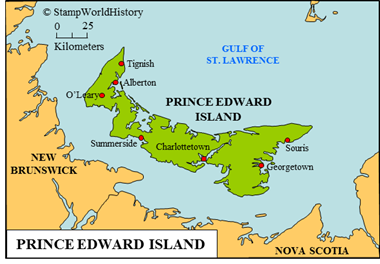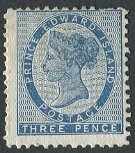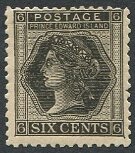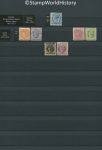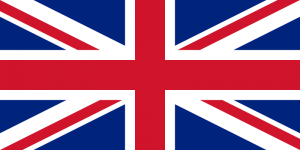
Prince Edward Island
Quick reference
General issues: British colony 1861-1873
Country name on general issues: Prince Edward Island
Currency: 1 Shilling = 12 Pence 1861-1872, 1 Dollar = 100 Cents 1872-1873
Population: 80 900 in 1861
Political history Prince Edward Island
Prince Edward Island is located in North America as one of the Maritime Provinces of modern day Canada. Prior to colonization, Prince Edward Island was inhabited by the Amerindian Mi’kmaq or Micmac people – a people also found in the other Maritime Provinces. Prince Edward Island was, possibly, settled temporarily by the Norsemen around 1 000 AD and sighted by the Italian explorer Giovanni Caboto – also referred to by his English name of John Cabot – who explored the Atlantic Coast of Canada in 1497. The first documented European sighting, however, was by the French explorer Jacques Cartier in 1534. Although claimed for France, Prince Edward Island – then called Îsle Saint-Jean – was not actively colonized by the French until 1720. French rule would be short lived – the British occupied Prince Edward Island in 1758 and the island was formally ceded to Britain in 1763.
The British first attached Saint John’s Island – as the British now called it – to the existing British colony of Nova Scotia. Shortly after, in 1769, Saint John’s Island was made a separate colony. In 1799, Saint John’s Island was renamed Prince Edward Island. In 1864, the first of a series of conferences leading to the establishment of the federal Dominion of Canada was held in Charlottetown, the capital of Prince Edward Island. However, when the Dominion of Canada was actually established in 1867, Prince Edward Island declined to join. After continued negotiations, Prince Edward Island finally joined the federation in 1873. Prince Edward Island has been a province of Canada since then.
Economically, agriculture and fishing have been the most important sectors from colonial times until today. In the 20th century tourism has also become a significant contributor to the GDP of the province. Prince Edward Island has, however, known less economic development than Canada overall. In terms of per capita GDP, Prince Edward Island ranks lowest of the Canadian provinces and territories. Of today’s population 39% identifies itself as Scottish, 31% as English, 30% as Irish and 21% as French. French is the first language of 4% of the population. The indigenous Mi’kmaq account for about 1% of the population.
Postal history Prince Edward Island
Prince Edward Island issued its first stamps in 1861. All issues show the portrait of Queen Victoria. The first two sets issued use the same portrait in a number of different frames for the different denominations. In 1870, a portrait known as the ‘Chalon Head’ is used.[1]For more about the Chalon Heads, please refer to the profile of Nova Scotia. The third and last set issued uses a slightly different portrait of the Queen, again with different frames for the different denominations – the denomination now being in cents. The stamps of Prince Edward Island were superseded by the stamps of the Dominion of Canada in 1873.
Album pages
← Previous page: Canadian Provinces - Nova ScotiaNext page: Caribbean Netherlands →

